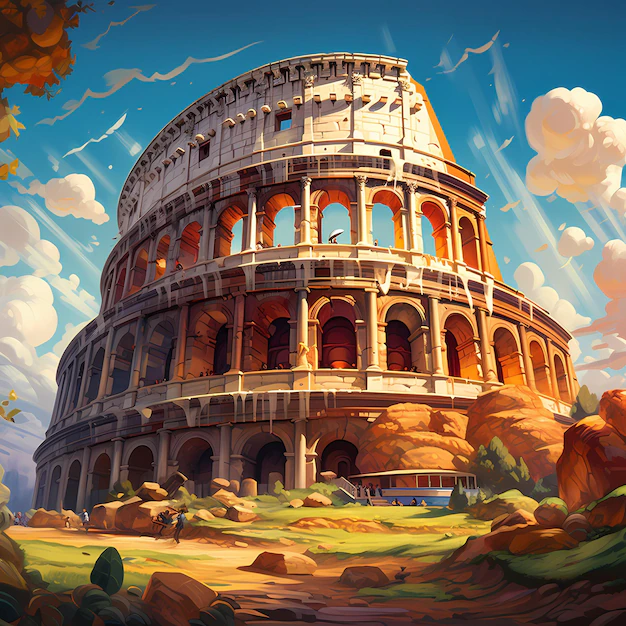Roman architecture is a captivating blend of artistry and engineering that has left an indelible mark on the world. From grand structures to intricate details, the Romans created architectural wonders that continue to inspire awe and admiration today. In this article, we will delve into the secrets of Roman architecture, exploring its key characteristics, the influence of Greek architecture, famous examples, and its enduring legacy.
Key Characteristics of Roman Architecture
Roman architecture is characterized by its grandeur, symmetry, and attention to detail. One of the key features of Roman architecture is the use of arches and vaults. The Romans perfected the technique of constructing arches, allowing them to build larger and more stable structures. The arches not only provided structural support but also added a touch of elegance to the buildings.
Another defining characteristic of Roman architecture is the use of concrete. The Romans were the first to extensively use concrete in their construction projects, enabling them to create monumental structures with precision and durability. The use of concrete also allowed for the incorporation of intricate details, such as decorative motifs and sculptural reliefs.
The Influence of Greek Architecture on Roman Architecture
Greek architecture greatly influenced Roman architecture, serving as a foundation for the Romans to build upon. The Romans admired the Greek architectural style and incorporated many of its elements into their own designs. However, they added their own unique touch, adapting and evolving the Greek architectural principles to suit their needs.
One of the most notable examples of this Greek influence is the use of columns. The Romans adopted the Greek column orders, including the Doric, Ionic, and Corinthian, but modified them to create their own distinct style. They employed columns not only for structural support but also as decorative elements, often using them to create a sense of grandeur and monumentality in their buildings.
Famous Examples of Roman Architecture
The Romans left behind a treasure trove of architectural masterpieces that continue to inspire awe and wonder. One of the most iconic examples of Roman architecture is the Colosseum. This magnificent amphitheater, built in Rome during the Flavian dynasty, is a testament to Roman engineering and innovation. Its elliptical shape, tiered seating, and intricate network of corridors and chambers showcase the Romans’ mastery of architectural design.
Another famous example of Roman architecture is the Pantheon. This awe-inspiring temple, dedicated to all the gods of ancient Rome, is renowned for its massive dome and innovative architectural techniques. The dome of the Pantheon, with its oculus at the top, is a remarkable feat of engineering and remains the largest unreinforced concrete dome in the world.
The Roman Aqueducts: Engineering Marvels of the Ancient World
The Roman aqueducts stand as a testament to the Romans’ engineering prowess and their ability to create sophisticated systems to transport water over long distances. These impressive structures, consisting of a series of arches and tunnels, were built to supply water to the cities and towns of the Roman Empire.
The aqueducts were constructed with meticulous precision, using a combination of gravity and the natural slope of the land to ensure a steady flow of water. The Romans employed various techniques, such as the use of inverted siphons, to overcome obstacles and maintain a consistent water supply. These engineering marvels not only provided water for daily use but also facilitated the development of thriving communities and flourishing civilizations.
The Enduring Legacy of Roman Architecture
The legacy of Roman architecture can be seen all around us, from government buildings to religious structures and even in our own homes. The Romans’ architectural innovations, such as the use of arches, vaults, and concrete, have greatly influenced subsequent architectural styles and continue to shape modern design.
The principles of Roman architecture, such as symmetry, proportion, and harmony, are still valued and applied in architecture today. The concept of a central plan, often seen in Roman buildings like the Pantheon, has been embraced by architects throughout history. The use of arches and vaults, which originated in Roman architecture, can be found in countless buildings worldwide.
Exploring Roman Architecture Today
Today, we have the privilege of exploring and experiencing Roman architecture firsthand. Many of the ancient Roman structures have been preserved and are open to the public, allowing us to step back in time and marvel at the ingenuity of the Romans.
Visiting the Colosseum in Rome is a must for any architecture enthusiast. The sheer scale and grandeur of this iconic amphitheater is awe-inspiring. Walking through its corridors and witnessing the remnants of its once-spectacular interior is an experience that transports you back to the glory days of the Roman Empire.
Conclusion
Roman architecture is a testament to the ingenuity and creativity of the ancient Romans. Through their mastery of engineering and design, they created architectural wonders that continue to inspire and captivate us today. From the grandeur of the Colosseum to the innovative dome of the Pantheon, the legacy of Roman architecture is one that will forever shape the world of architecture. So, next time you find yourself admiring a magnificent building or marveling at a beautifully designed space, remember the secrets of Roman architecture that lie beneath its surface.



